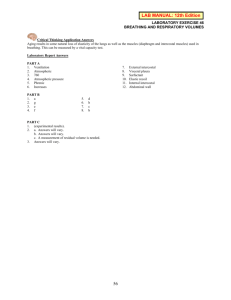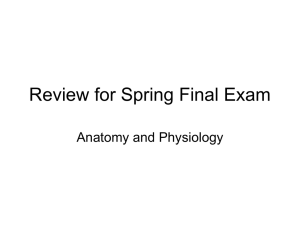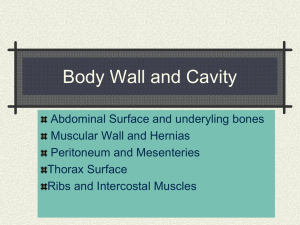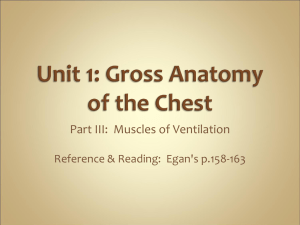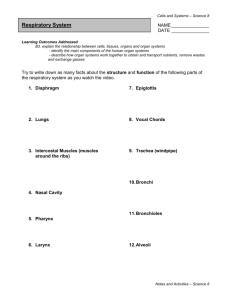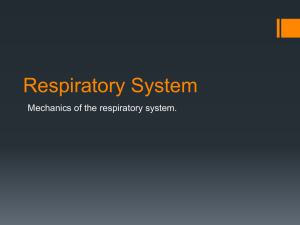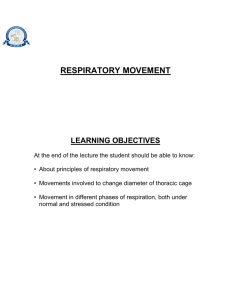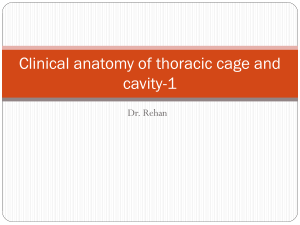02 the_muscles_invol..
advertisement
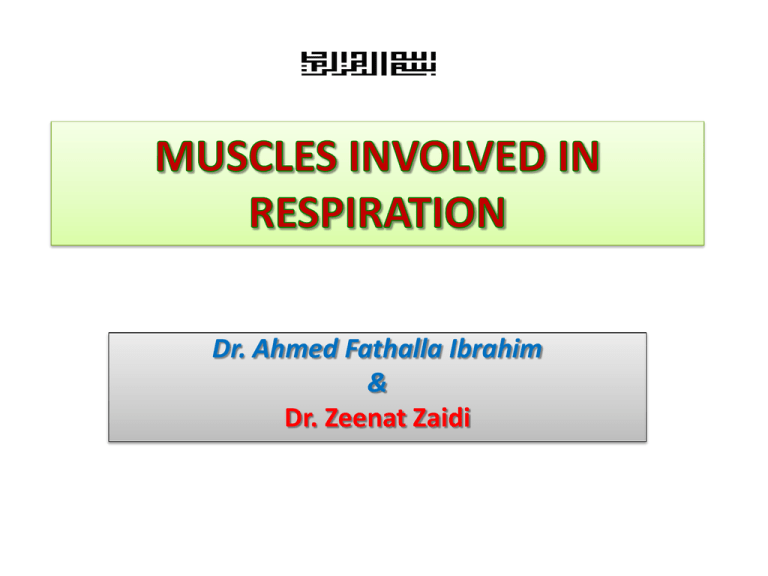
Dr. Ahmed Fathalla Ibrahim & Dr. Zeenat Zaidi OBJECTIVES At the end of the lecture, students should be able to: Describe the components of the thoracic cage and their articulations. Describe in brief the respiratory movements. List the muscles involved in inspiration and in expiration. Describe the attachments of each muscle to the thoracic cage and its nerve supply. Describe the origin, insertion, nerve supply of diaphragm. THORACIC CAGE Conical in shape Formed of: Sternum & costal cartilages: anteriorly Twelve pairs of ribs: laterally Twelve thoracic vertebrae: posteriorly Has 2 apertures (openings): 1. Superior (thoracic outlet): narrow, open, continuous with neck 2. Inferior: wide, closed by diaphragm Articulations Costovertebral Costochondral Sternocostal Respiratory Movements A- Movements of Diaphragm Inspiration Contraction (descent) of diaphragm Increase of vertical diameter of thoracic cavity Expiration Relaxation (ascent) of diaphragm) Respiratory Movements B- Movements of Ribs PUMP HANDLE MOVEMENT Elevation of ribs Increase in antero-posterior diameter of thoracic cavity BUCKET HANDLE MOVEMENT Elevation of ribs Increase in lateral diameter of thoracic cavity Inspiratory Muscles Diaphragm (most important muscle) Rib elevators: external intercostal muscles Accessory muscles (only during forced inspiration): 1. Muscles attaching cervical vertebrae to first & second rib: scalene muscles 2. Muscles attaching thoracic cage to upper limb: pectoralis major DIAPHRAGM • A musculotendinous partition between thoracic & abdominal cavity • Convex toward thoracic & concave toward abdominal cavity • Origin: 1. Costal: lower 6 costal cartilages & 12th rib 2. Vertebral: bodies of first three lumbar vertebrae and their intervertebral discs on right side & bodies of first two lumbar vertebrae and their intervertebral discs on left side (right & left crus) and the arcuate ligaments. 3. Sternal: xiphoid process of sternum Medial & lateral arcuate ligaments • Insertion: Fibers converge to join the central tendon • Nerve supply: phrenic nerve (C3,4,5), penetrates diaphragm & innervates it from abdominal surface • Action: contraction (descent) of diaphragm increases vertical diameter of thoracic cavity (essential for normal breathing) EXTERNAL INTERCOSTAL Attachments: from lower border of rib above to upper border of rib below Direction of fibers: downward & medially Nerve supply: intercostal nerves Action: rib elevators (inspiratory) SCALENE MUSCLES Three muscles: 1. Scalenus anterior 2. Scalenus medius 3. Scalenus posterior Origin: cervical vertebrae Insertion: 1st & 2nd ribs Action: elevate 1st & 2nd ribs (inspiratory) Cervical vertebrae 2 1 3 PECTORALIS MAJOR Origin: sternum + costal cartilages Insertion: humerus Action: increases antero-posterior diameter of thoracic cavity, when arm is fixed (inspiratory) Expiratory Muscles Act only during forced expiration • Rib depressors: Internal intercostal Innermost intercostal Subcostals Transversus thoracis • Anterior abdominal wall muscles: External oblique Internal oblique Transversus abdominis Rectus abdominis RIB DEPRESSORS 1. Internal intercostal 2. Innermost intercostal Direction: upward & medially 3. Subcostal 4. Transversus thoracis Nerve supply: intercostal nerves (ventral rami of T1-T11) 3 1 2 4 Anterior abdominal wall Is formed of 3 layers of muscles of fibers running in different directions (to increase strength of anterior abdominal wall) The 3 muscles form a tendinous sheath in which a fourth muscles lies (rectus abdominis) Muscles are attached to: sternum, costal cartilages and ribs + hip bones The aponeurosis of the 3 muscles on both sides fuse in the midline to form linea alba Action (during forced expiration): Compression of abdominal viscera to help in ascent of diaphragm (during forced expiration) Nerve supply: lower intercostal nerves (T7 – T11), subcostal nerve (T12) and first lumbar nerve. Anterior abdominal wall Muscles External oblique (outer layer) Internal oblique (middle layer) Direction: downward & medially Direction: upward & medially Linea alba Transversus abdominis (inner layer) Direction: transverse Rectus abdominis Direction: vertical THANK YOU
